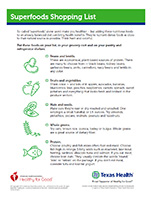Texas Health is proud to be the North Texas Go Red for Women Cause sponsor, joining the American Heart Association in the nationwide movement dedicated to raising awareness, improving health and ending heart disease as the No. 1 killer of women. Texas Health is committed to inspiring and empowering women to better achieve health and well-being through education, personal action and collective impact.
With so many diets offering mixed messages about what to avoid and what to stock up on, eating healthy can be confusing. Who wouldn’t welcome a heroic assortment of cape-wearing, “S” emblazoned Superfoods? Foods that would swoop in and save you from processed food and fast food! Foods that could improve your health simply and deliciously.
So-called superfoods alone won’t make you healthier, but adding these nutritious foods to an already-balanced diet can bring health benefits. And superfoods are actually plentiful. Think beans, broccoli, barley, berries, walnuts and salmon, to name a few. They’re nutrient-dense and must-haves for anyone who wants to feel good and reduce their risk of developing heart disease, diabetes, obesity and some kinds of cancers.
Yet, in our busy lives, many of us default to processed and fast foods. If you eat a lot of highly processed foods, you risk getting too much sodium, added sugars and unhealthy fats. Highly processed foods contribute almost 60 percent of calories and 90 percent of added sugars in the American diet, according to a 2016 research study.
Superfoods, by contrast, are rich in vitamins, minerals and other nutrients, without too much saturated fat, added sugars and sodium.
“It’s really not all that complicated,” says internist Ruby Shah, M.D., who is CEO and founder of Vitality Weight Loss and Wellness Institute and a physician on the medical staff of Texas Health Plano. “It’s knowing that diets and fads come and go, and you need to stick to the basics, to eat foods that are unprocessed or minimally processed. They’re vegetables, fruits, whole grains, mainly plant-derived foods.”
Lists abound about what should and shouldn’t be eaten, but the most reliable ones have this in common: nutrient-dense foods that encompass a rainbow of colors. The more colorful the food, the more of a nutritional powerhouse it is — red peppers, orange carrots, yellow squash, green kale, blueberries, indigo-blue potatoes and purple eggplant.
“These foods are high in antioxidants, vitamins, minerals and fiber,” Shah notes. “They’re also low in calories.”
A caveat: They’re superfoods only when eaten in their purest form. Turn a vegetable into a vegetable chip and it becomes a processed food with added preservatives, unpronounceable ingredients and little to no nutritional value, according to Shah. Order a fruit smoothie, and it can turn into a sugar-infused drink.
“A major source of calories in the United States is sugar,” she says. “We eat that more than anything because sugar is the most common preservative. People don’t think of that.”
One way to cut back on sugar is to cut back on preservatives by eating less processed food and cooking your own food. That doesn’t have to take any longer than waiting in line at a fast-food restaurant.
“We overcomplicate cooking,” Shah adds. “We think it’ll have to be a whole fancy meal, but simple meals can be made in five or 10 minutes and definitely less than 30.”
One of Shah’s favorite meals combines beans and brown rice. Top it with turnip greens, spinach or Swiss chard and “you have an A-plus meal with all that nutrition, plus it’s cheap and easy.”
She provides these additional tips to help supersize your superfood intake:
Make healthy easy. Put a container with healthy foods in the fridge at a high level, and keep fruits and vegetables on the counter. The biggest driver of what most people eat is what they see.
Focus on tried-and-true healthy foods over variety. “People say, ‘I’m eating the same thing every day. Is that OK?’ I tell them sure, as long as it’s healthy,” Shah says.
Pick nine go-to superfoods. Choose three for breakfast, three for lunch and three for dinner. That way, you won’t be agonizing over what you’ll have every day, every meal. Shah’s breakfast choices? Steel-cut oatmeal, chia seeds and blueberries. Lunch and dinner choices might include carrots, lean meat, brown rice and black beans.
Focus on whole grains. Your body needs this kind of carbohydrate, which includes quinoa, brown rice, barley and bulgur. It doesn’t necessarily mean whole-wheat bread, which can have a lot of preservatives, but check the label. The fewer ingredients, the better.
Be sure to include healthy fats. “These are polyunsaturated fats, monounsaturated fats, and omega-6 and omega-3 fatty acids, which are important because your body doesn’t make them,” Shah explains. “They’re instrumental in lowering LDL cholesterol. They can be found in flaxseed, walnuts and chia seeds.” Because they are fats and have significant calories, use them as replacements for other less healthy fats, not in addition to those.
Don’t forget protein. Protein is huge, especially for weight loss. It has a lot of macronutrients, which the body needs. Plant-based proteins include tofu and lentils. For fish-based options, consider salmon, tuna or sardines, which are also high in omega-3. Animal-based options might include skinless chicken breasts.
“Remember, no one is perfect. Sure, we’re all going to eat processed food; how can we minimize it? Aim for 80 percent whole foods and 20 percent processed as a good rule of thumb,” she adds.
Learn more tips on how to keep your heart healthy and stay ahead of heart disease and find a heart and vascular specialist today.
Doctors on the medical staffs practice independently and are not employees or agents of Texas Health hospitals or Texas Health Resources.


